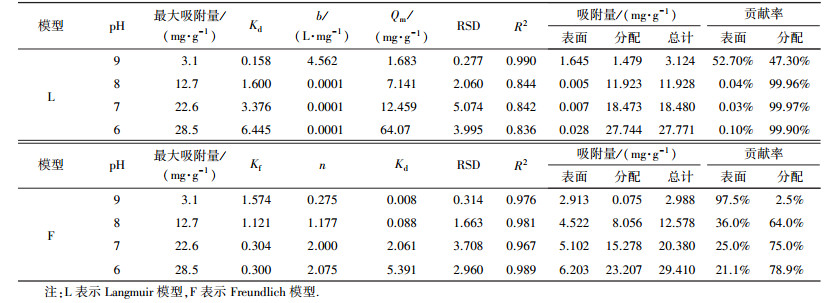四溴双酚A(TBBPA)作为目前全球用量最大的溴代阻燃剂(Makinen et al., 2009;Sun et al., 2008), 在电子产品、纺织品和塑料产品中均有广泛的应用(De Wit, 2002;Domingo, 2004;Gill et al., 2004;Liu et al., 2005;Liu et al., 2016), 在环境中的残留量也日益增加.目前, 研究人员已在土壤(苑金鹏, 2013;Watanale et al., 1983;Huang et al., 2014)、沉积物(Paula et al., 2010;Zhao et al., 2013;Yang et al., 2012)、水体(Yang et al., 2012;Zhang et al., 2009)甚至是人体血液中检测到了TBBPA, 其在环境中的暴露已成为全球问题(De Wit, 2002).另有研究表明, TBBPA对哺乳动物和鱼类具有慢性毒性作用, 可导致生理学影响或疾病(Eriksson et al., 2002;Lilienthal et al., 2008;Szymańska et al., 2001;Tada et al., 2007;Wu et al., 2016;Szychowski et al., 2016;Borghoff et al., 2016).
在煤的开采、贮存和加工运输过程中会产生大量的煤粉, 其中小于10 μm的部分称为煤胶体(Stumm et al., 1977), 同时在燃煤过程中也会产生大量10 μm以下的细颗粒物(张凯等, 2015).煤胶体具有表面粗糙、有微孔、比表面积大、含氧官能团丰富等特点, 是一种天然吸附剂.研究发现, 重金属、有机污染物、病毒、农药等污染物均可吸附于煤胶体之上(刘庆玲等, 2005;殷宪强, 2010;许端平等, 2015a), 并通过胶体的优先流而加速其在地表水、地下水和土壤中的运移, 进而增强了污染物的移动性(唐颖等, 2014;许端平等, 2015b).
TBBPA在煤胶体上的吸附作用会影响其在环境中的归趋, 因此, 本文以采自内蒙古霍林河煤矿的煤样为研究对象, 研究煤胶体对TBBPA的吸附特性, 重点探讨温度、pH值和离子强度对TBBPA在煤胶体上表面吸附和分配作用的影响.这对预测TBBPA在矿区周围环境中的运移行为有着重要的意义.
2 材料与方法(Materials and methods) 2.1 煤胶体的制备实验所用煤样品采集于内蒙古霍林河矿区.煤样品经风干去杂质后, 过0.085 mm筛备用.胶体提取采用离心和沉降的方法, 称取60 g煤粉样品于烧杯中, 加入2000 mL去离子水, 超声30 min(每5 min搅拌一次), 在750 r·min-1下离心3.5 min, 用虹吸法提取上清液, 其中颗粒为粒径小于5 μm的煤胶体.将上述上清液在1500 r·min-1下离心5 min, 用虹吸法提取上清液, 沉降得到的固体即为2~5 μm的煤胶体, 在50 ℃下烘干后, 置于自封袋中备用.
2.2 TBBPA的理化性质TBBPA购于上海笛柏化学品技术有限公司, 纯度>98%, 在水中的溶解度为4.16 mg·L-1(25 ℃), 水分配系数lgKow为4.5(WHO, 1995).TBBPA化学稳定性强, 无可燃性、爆炸性及氧化性, 微溶于水而极易溶于有机溶剂中.
2.3 煤胶体性质分析配置煤胶体悬浮液, 超声分散30 min, 用LA-300型激光粒度仪测定其粒径分布.配置胶体悬浮液, 使用0.01 mol·L-1 HCl和0.01 mol·L-1 NaOH精确调节悬浮液pH, 用JS94Zeta电位仪测定不同pH条件下胶体悬浮液的Zeta电位值.采用BET法测胶体的比表面积.
2.4 等温吸附实验不同pH(pH=6、7、8、9) 下煤胶体对TBBPA的等温吸附实验:准确称取0.01 g粒级为2~5 μm的煤胶体于一系列100 mL具塞磨口棕色锥形瓶中, 均加入50 mL一系列pH=9(溶液pH用0.5 mol·L-1的NaOH和0.5 mol·L-1的HCl调节, 调节pH时所用酸碱的比例较小, 不会对溶液浓度造成显著影响)的浓度为0.5、1、2、4、5、7、8、10 mg·L-1的TBBPA溶液, 所有锥形瓶在恒温振荡箱中以45 ℃、150 r·min-1的速度振荡48 h(根据动力学实验结果).移取20 mL上清液至离心管, 4000 r·min-1离心30 min, 将离心好的上清液过孔径为0.45 μm的玻璃纤维膜, 准确取出10 μL上清液用于测定TBBPA的浓度.用同样的方法配置pH=8、7、6的相同浓度梯度的TBBPA溶液, 重复上述实验.
不同Ca2+浓度下煤胶体对TBBPA的等温吸附实验:调节TBBPA溶液的pH为6, 加入CaCl2使溶液中Ca2+浓度分别为0.1、0.01、0.001 mol·L-1, 在45 ℃下振荡, 其余步骤重复上述实验.
不同温度下煤胶体对TBBPA的等温吸附实验:控制恒温振荡箱温度分别为25、35、45 ℃, 调节TBBPA溶液的pH为9, 不添加Ca2+, 其余步骤重复上述实验.各实验均重复3次, 结果取3次的平均值.
2.5 TBBPA的分析方法溶液中TBBPA的浓度采用高效液相色谱(Shimadzu 20AD)测定, 紫外检测器, C18色谱柱, 流动相为甲醇和水(体积比, 85:15), 流速为1 mL·min-1, 检测波长为210 nm.
2.6 等温吸附方程为了解分配作用和表面吸附在煤胶体对TBBPA吸附过程中的贡献, 可用Langmuir(式(1))和Freundlich(式(2))吸附-分配复合模型(夏星辉等, 2005)来描述其吸附过程.

|
(1) |

|
(2) |
式中, Q为固相吸附量(mg·g-1);Qmax为给定固相的最大表面吸附量(mg·g-1);b为Langmuir常数(L·mg-1);Ce为液相平衡浓度(mg·L-1);Kp为分配系数;Kif为Freundlich常数或容量因子;n为Freundlich指数.
3 结果与讨论(Results and discussion) 3.1 煤胶体的主要性质提取的煤胶体粒径分布如图 1所示, 其中, 粒径在2~5 μm的煤基胶体占61.44%, d50=2.62 μm, 粒径 < 2 μm的煤基胶体占27.77%, 粒径>5 μm的煤基胶体占10.79%.
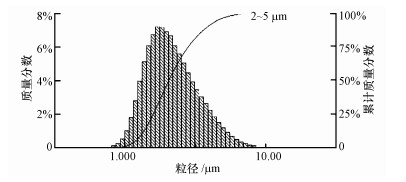 |
| 图 1 煤基胶体粒径分布 Fig. 1 Diameter distribution of colloids from coal |
煤基胶体在不同pH下的Zeta电位值如表 1所示.可以看出, 胶体带负电, 且随pH的增加, 胶体的电负性增加, 即水中的H+能中和胶体表面的部分负电荷.所提取粒径为2~5 μm煤基胶体的BET比表面积为48.18 m2·g-1.
| 表 1 不同pH条件下煤基胶体悬浮液Zeta电位 Table 1 Zeta potential of colloids from coal as a function of solution pH |
不同pH值下TBBPA在煤胶体上的吸附等温线如图 2所示.由图 2可见, 粒径为2~5 μm的煤胶体在pH=6时的实验最大吸附量分别是pH=7、8、9时的1.26、2.24、9.19倍, 表明pH越低越有利于煤胶体吸附TBBPA.
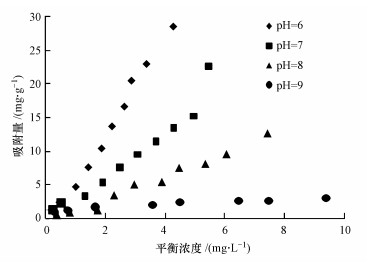 |
| 图 2 不同pH值下煤胶体对TBBPA的吸附等温线 Fig. 2 Sorption isotherms of TBBPA on colloids from coal under different pH |
夏星辉等(2005)指出, 在自然条件下, 沉积物对污染物的吸附过程是复杂的, 并不是单一的表面吸附或是分配作用.因此, 为了进一步了解表面吸附和分配作用在煤胶体对TBBPA吸附过程中的贡献, 以及pH对TBBPA在煤胶体上表面吸附和分配作用的影响, 采用Matlab软件, 分别用吸附-分配复合模型(式(1) 和(2))来拟合实验数据, 结果见表 2.
| 表 2 不同pH值下表面吸附-分配复合模型拟合参数 Table 2 Parameters obtained from the adsorption-partition model under different pH |
由表 2可知, 在不同pH值下, 煤胶体对TBBPA的吸附过程可由Freundlich表面吸附-分配复合模型很好地描述, R2值为0.967~0.989, 优于Langmuir表面吸附-分配复合模型拟合的效果;标准差(RSD)为0.314~3.708, 拟合所得到的吸附量与实验所得相差不大, 表明煤胶体对TBBPA的吸附作用是表面吸附和分配作用的叠加.
在不同pH值下, 煤胶体对TBBPA的表面吸附和分配作用的吸附量及占总吸附量的比例明显不同.在pH值为9时, TBBPA在煤胶体上的吸附以表面吸附为主, 占总吸附量的97.5%;而在pH值为6~8时, 则以分配作用为主, 占总吸附量的64.0%~78.9%.而随pH值的增大, TBBPA在煤胶体上分配作用和表面吸附的吸附量均逐渐减小, pH值为9时分配作用和表面吸附的吸附量分别是pH值为6时的0.3%和47.0%, 可见pH值对分配作用的影响明显大于表面吸附.同时, 两种作用的吸附量占总吸附量的比例呈相反的趋势, pH值越大表面吸附所占比例越大, 而分配作用则相反.
Arnon等(2006)发现, 在pH < 7.5时, TBBPA的溶解度 < 0.2 mg·L-1;pH>8时, TBBPA的溶解度迅速增加;pH=9时, TBBPA的溶解度可以达到500 mg·L-1.因此, 随pH值的增大, TBBPA的溶解度变大, 使TBBPA在煤胶体上的分配作用明显下降;而由于随pH值的增大, 胶体的电负性增加, TBBPA的离子同样带有负电荷, 使得其与煤胶体之间的斥力增大, 减少其在煤胶体上的表面吸附.
3.3 离子强度对TBBPA在煤胶体上表面吸附和分配作用的影响不同离子强度下TBBPA在煤胶体上的吸附等温线如图 3所示.由图 3可见, 与未添加Ca2+相比, 添加Ca2+时, 煤胶体对TBBPA的吸附量有明显的增加, 但在所添加的Ca2+浓度范围内, 煤胶体对TBBPA的吸附量则变化不大.其原因可能是由于煤胶体本身带负电, 而TBBPA离子也带负电, 二者之间存在斥力, 而Ca2+的加入在煤胶体和TBBPA离子间形成了键桥作用, 增加二者的接触几率, 从而使煤胶体对TBBPA的吸附量增加, 但由于TBBPA的初始浓度较低, 因此, Ca2+浓度为0.001~0.1 mol·L-1时, 随其浓度的增加, 煤胶体对TBBPA吸附量差异不大.
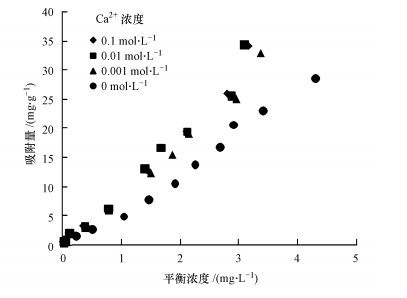 |
| 图 3 不同离子强度下煤胶体对TBBPA的吸附等温线 Fig. 3 Sorption isotherms of TBBPA on colloids from coal at the different ionic strengths |
分别用吸附-分配复合模型(式(1) 和(2))对不同离子强度下煤胶体对TBBPA吸附的实验数据进行拟合, 结果见表 3.由表 3可见, Ca2+浓度为0.001~0.1 mol·L-1时, 煤胶体对TBBPA的吸附过程可由Freundlich表面吸附-分配复合模型很好地描述, 其R2值为0.982~0.994, 优于Langmuir表面吸附-分配复合模型拟合的效果, 其标准差为2.442~4.780.
| 表 3 不同离子强度下表面吸附-分配复合模型拟合参数 Table 3 Parameters obtained from the adsorption-partition model atdifferent ionic strengths |
与未加入CaCl2相比, 加入Ca2+后表面吸附的吸附量略有增加, 可能是由于Ca2+在煤胶体和TBBPA离子间形成了键桥作用.而随Ca2+浓度的增大, 煤胶体对TBBPA的分配作用和表面吸附的吸附量都基本没有变化, 说明在此范围内离子强度对于煤胶体对TBBPA的吸附影响较小.
3.4 温度对TBBPA在煤胶体上表面吸附和分配作用的影响不同温度下TBBPA在煤胶体上的吸附等温线如图 4所示.由图 4可见, 温度对TBBPA在煤胶体上的吸附影响显著, 随温度升高, 煤胶体对TBBPA的吸附量逐渐降低, 表明其吸附主要是物理吸附.
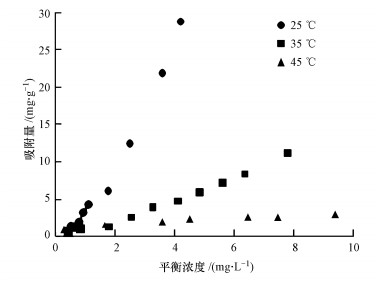 |
| 图 4 不同温度下煤胶体对TBBPA的吸附等温线 Fig. 4 Sorption isotherms of TBBPA oncolloids from coal under different temperatures |
分别用吸附-分配复合模型对不同温度下煤胶体对TBBPA吸附的实验数据进行拟合, 结果见表 4.由表 4可见, 在25~45 ℃下, 煤胶体对TBBPA的吸附过程可由Freundlich表面吸附-分配复合模型很好地描述, 其R2值为0.976~0.998, 优于Langmiur表面吸附-分配复合模型拟合的效果, 其标准差为0.314~1.582.
| 表 4 不同温度下表面吸附-分配复合模型拟合参数 Table 4 Parameters obtained from the Adsorption-Partition model underdifferent temperatures |
在25~45 ℃下, 随温度的升高, 表示TBBPA在煤胶体上表面吸附能力的Kf值与表示TBBPA在煤胶体上分配作用吸附能力的Kd值均逐渐减小, TBBPA在煤胶体上吸附的分配作用和表面吸附同样都有所下降.但温度的升高对分配作用的影响程度较大, 45 ℃时分配作用的吸附量为25 ℃时的0.86%, 45 ℃时表面吸附的吸附量为25 ℃时的14.5%.
4 结论(Conclusions)1) 煤胶体对TBBPA有较强的吸附能力, 在本实验条件下, 最大吸附量可达32.682 mg·g-1.煤胶体对TBBPA的吸附过程可由Freundlich表面吸附-分配复合模型很好地描述, 表明煤胶体对TBBPA的吸附作用是表面吸附和分配作用的叠加.
2) 在不同pH值下, 煤胶体对TBBPA的表面吸附和分配作用的吸附量及占总吸附量的比例明显不同.在pH值为9时, TBBPA在煤胶体上的吸附以表面吸附为主;而在pH值为6~8时, 则以分配作用为主.
3) Ca2+浓度在0.001~0.1 mol·L-1范围内, 离子强度对TBBPA在煤胶体上的表面吸附和分配作用均影响较小.
4) 在25~45 ℃下, 随温度的升高, TBBPA在煤胶体上吸附的分配作用和表面吸附同样都有所下降.但温度的升高对分配作用的影响程度较大.
| [${referVo.labelOrder}] | Arnon S, Ronen Z, Yakirevich A, et al. 2006. Evaluation of soil flushing potential for clean-up of desert soil contaminated by industrial wastewater[J]. Chemosphere, 62(1): 17–25. DOI:10.1016/j.chemosphere.2005.04.050 |
| [${referVo.labelOrder}] | Borghoff S J, Wikoff D, Harvey S, et al. 2016. Dose-and time-dependent changes in tissue levels of tetrabromobisphenol A (TBBPA) and its sulfate and glucuronide conjugates following repeated administration to female Wistar Han Rats[J]. Toxicology Reports, 3: 190–201. DOI:10.1016/j.toxrep.2016.01.007 |
| [${referVo.labelOrder}] | De Wit C A. 2002. An overview of brominated flame retardants in the environment[J]. Chemosphere, 46(5): 583–624. DOI:10.1016/S0045-6535(01)00225-9 |
| [${referVo.labelOrder}] | Domingo J L. 2004. Human exposure to polybrominated diphenyl ethers through the diet[J]. Journal of Chromatography A, 1054(1/2): 321–326. |
| [${referVo.labelOrder}] | Eriksson P, Viberg H, Jakobsson E, et al. 2002. A brominated flame retardant, 2, 2', 4, 4', 5-pentabromodiphenyl ether: uptake, retention, and induction of neurobehavioral alterations in mice during a critical phase of neonatal brain development[J]. Toxicological Sciences, 67(1): 98–103. DOI:10.1093/toxsci/67.1.98 |
| [${referVo.labelOrder}] | Gill U, Chu I, Ryan J J, et al.2004.Polybrominated Diphenyl Ethers: Human Tissue Levels and Toxicology//Reviews of Environmental Contamination and Toxicology[M].New York:Springer.55-97 |
| [${referVo.labelOrder}] | Guerra P, Eljarrat E, Barceló D. 2010. Simultaneous determination of hexabromocyclododecane, tetrabromobisphenol A, and related compounds in sewage sludge and sediment samples from Ebro River basin (Spain)[J]. Analytical and Bioanalytical Chemistry, 397(7): 2817–2824. DOI:10.1007/s00216-010-3670-3 |
| [${referVo.labelOrder}] | Huang D Y, Zhao H Q, Liu C P, et al. 2014. Characteristics, sources, and transport of tetrabromobisphenol A and bisphenol A in soils from a typical e-waste recycling area in South China[J]. Environmental Science and Pollution Research, 21(9): 5818–5826. DOI:10.1007/s11356-014-2535-2 |
| [${referVo.labelOrder}] | Lilienthal H, Verwer C M, Ven L T M V D, et al. 2008. Exposure to tetrabromobisphenol A (TBBPA) in Wistar rats: neurobehavioral effects in offspring from a one-generation reproduction study[J]. Toxicology, 246(1): 45–54. DOI:10.1016/j.tox.2008.01.007 |
| [${referVo.labelOrder}] | 刘庆玲, 徐绍辉. 2005. 地下环境中胶体促使下的污染物运移研究进展[J]. 土壤, 2005, 37(2): 129–135. |
| [${referVo.labelOrder}] | Liu H X, Zhang Q H, Jiang G B, et al. 2005. Polybrominated diphenyl ethers and its related environmental problems[J]. Progress in Chemistry, 17(3): 554–562. |
| [${referVo.labelOrder}] | Liu K, Li J, Yan S, et al. 2016. A review of status of tetrabromobisphenol A (TBBPA) in China[J]. Chemosphere, 148: 8–20. DOI:10.1016/j.chemosphere.2016.01.023 |
| [${referVo.labelOrder}] | Mäkinen M S, Mäkinen M R, Koistinen J T, et al. 2009. Respiratory and dermal exposure to organophosphorus flame retardants and tetrabromobisphenol A at five work environments[J]. Environmental Science & Technology, 43(3): 941–947. |
| [${referVo.labelOrder}] | Stumm W. 1977. Chemical interaction in particle separation[J]. Environmental Science & Technology, 11(12): 1066–1070. |
| [${referVo.labelOrder}] | Sun Z, Yu Y, Mao L, et al. 2008. Sorption behavior of tetrabromobisphenol A in two soils with different characteristics[J]. Journal of Hazardous Materials, 160(2/3): 456–461. |
| [${referVo.labelOrder}] | Szychowski K A, Wójtowicz A K. 2015. TBBPA causes neurotoxic and the apoptotic responses in cultured mouse hippocampal neurons in vitro[J]. Pharmacological Reports Pr, 68(1): 20–26. |
| [${referVo.labelOrder}] | Szymańska J A, Piotrowski J K, Frydrych B. 1999. Hepatotoxicity of tetrabromobisphenol-A:effects of repeated dosage in rats[J]. Toxicology, 142(2): 87–95. DOI:10.1016/S0300-483X(99)00108-0 |
| [${referVo.labelOrder}] | Szymańska J A, Sapota A, Frydrych B. 2001. The disposition and metabolism of tetrabromobisphenol-A after a single i.p.dose in the rat[J]. Chemosphere, 45(4/5): 693–700. |
| [${referVo.labelOrder}] | Tada Y, Fujitani T, Ogata A, et al. 2007. Flame retardant tetrabromobisphenol A induced hepatic changes in ICR male mice[J]. Environmental Toxicology & Pharmacology, 23(2): 174–178. |
| [${referVo.labelOrder}] | 唐颖, 李航, 朱华玲, 等. 2014. SDBS/Na+对红壤胶体悬液稳定性的影响[J]. 环境科学, 2014, 35(4): 1540–1547. |
| [${referVo.labelOrder}] | Watanabe I, Kashimoto T, Tatsukawa R. 1983. Identification of the flame retardant tetrabromobisphenol-A in the river sediment and the mussel collected in Osaka[J]. Bulletin of Environmental Contamination and Toxicology, 31(1): 48–52. DOI:10.1007/BF01608765 |
| [${referVo.labelOrder}] | WHO.1995.Environmental Health Criteria 172: Tetrabromobisphenol A and Derivative [R].Geneva:WHO |
| [${referVo.labelOrder}] | Wu S M, Ji G, Liu J, et al. 2015. TBBPA induces developmental toxicity, oxidative stress, and apoptosis in embryos and zebrafish larvae (Danio rerio)[J]. Environmental Toxicology, 31(10): 1241–9. |
| [${referVo.labelOrder}] | 夏星辉, 余晖, 陈立. 2005. 黄河水体颗粒物对几种多环芳烃生物降解过程的影响[J]. 环境科学学报, 2005, 25(9): 1226–1231. |
| [${referVo.labelOrder}] | 许端平, 李慧建, 王鹏, 等. 2015. 煤基胶体对草甘膦的吸附特征研究[J]. 地球与环境, 2015, 43(3): 316–321. |
| [${referVo.labelOrder}] | 许端平, 李晓波, 薛杨, 等. 2015. 不同环境条件下的煤基胶体稳定性[J]. 煤炭学报, 2015, 40(8): 1936–1941. |
| [${referVo.labelOrder}] | 殷宪强. 2010. 胶体对铅运移的影响及铅的生物效应[D]. 杨凌: 西北农林科技大学 |
| [${referVo.labelOrder}] | 苑金鹏. 2013. 溴代阻燃剂的分析方法及其在黄河三角洲土壤中的污染特征[D]. 济南: 山东大学 |
| [${referVo.labelOrder}] | Yang S, Wang S, Liu H, et al. 2012. Tetrabromobisphenol A: tissue distribution in fish, and seasonal variation in water and sediment of Lake Chaohu, China[J]. Environmental Science and Pollution Research, 19(9): 4090–4096. DOI:10.1007/s11356-012-1023-9 |
| [${referVo.labelOrder}] | Zhang X L, Luo X J, Chen S J, et al. 2009. Spatial distribution and vertical profile of polybrominated diphenyl ethers, tetrabromobisphenol A, and decabromodiphenylethane in river sediment from an industrialized region of South China[J]. Environmental Pollution, 157(6): 1917–1923. DOI:10.1016/j.envpol.2009.01.016 |
| [${referVo.labelOrder}] | 张凯, 龚本根, 田冲, 等. 2015. 燃煤细颗粒物排放实验及形成机理[J]. 煤炭学报, 2015, 40(11): 2696–2701. |
| [${referVo.labelOrder}] | Zhao M D, Yang S W, He-Ping L I, et al. 2013. Determination of tetrabromobisphenol-A exposed in surface sediment and fishes from erhai lake[J]. Research of Environmental Sciences, 26(2): 160–165. |
 2017, Vol. 37
2017, Vol. 37




